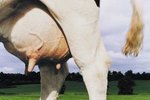
Large dairy producers use fancy milking machines on their cows, but there's no need for that if you have one cow or just a few. Hand milking techniques perfected over centuries still work today. Not all techniques work with all cows, but one allows you to check for mastitis before moving forward with the milking process.
Initial Cleaning
Cleaning your hands and the cow's udder helps reduce the chance she'll end up with mastitis, or an infection in the udder. Wash your hands with soap and water, then use the proper technique to clean the udder. Wipe the bottom and sides of the udder with a clean, damp towel, the dry it completely with another towel. Any dampness left on the udder can lead to the skin cracking or flaking as you milk her. After you're finished milking, dip each teat in a small cup of iodine or teat dip to cleanse it and remove any bacteria that might invade the udder.
Stripping Technique
When you're ready to start milking the cow, grab a teat in each hand, holding it between your thumb and forefinger. Start at the top of the teat, then slide your thumb and forefinger down the length of the teat, compressing it as you slide. Squirt a few streams out of each teat in this manner into separate cups, then check the milk for signs of mastitis, such as flakes or clumps in the milk. Never drink milk from an infected teat. After squirting out enough milk to inspect, stop the stripping technique. The friction from sliding your fingers down the teat can irritate the cow's skin. At the end of your milking session, use the stripping technique for a few squirts; the last dribbles of milk often are richer than the rest.
Full-Hand Technique
The proper technique for the majority of your milking time is using your full hand. Grasp the top of the teat by wrapping your thumb and forefinger around it, then compress the teat and wrap your other fingers around it as you squeeze. This forces milk already in the teat out in a stream without sliding your hand up and down the teat. Release the compression without fully letting go of the teat. This allows more milk to drop from the udder into the teat so you can compress your fingers from top to bottom and squeeze out the milk. Because your hand isn't sliding on the teat, it reduces the chance of irritation to the cow.
Which Side of the Cow
A cow who is not used to being milked won't care which side you work from; there's no set rule you must use to choose a side. However, it's important to always work from the side the cow is comfortable with. When you choose a side, or if someone has milked the cow previously, use the same side every time you milk. This helps the cow relax. In the United States, most people approach the cow from the right side to milk, although people in other countries, such as India, often milk from the left.
References
Photo Credits
-
Steve Baccon/Digital Vision/Getty Images




